We use cookies to ensure that we give you the best experience on our website. If you continue without changing your settings, we will assume that you are happy to receive all cookies on the Business Car website. However, if you would like to, you can change your cookies at any time

The start point for the best source of fleet information |
Final report: Volkswagen Golf long-term test
Date: 04 October 2021 | Author: Richard Bush
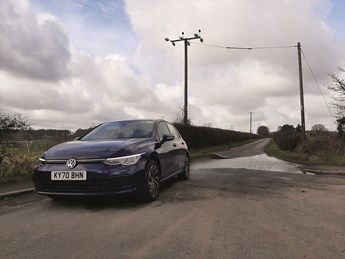
|
|
||||||||||||
Final Report: The Golf, the bad and the ugly
All cars must change with the times, even ubiquitous mainstays like the Golf. True, the boxy shape of the model has remained relatively unchanged over the past ten to 15 years, but its innards have been constantly reworked to accommodate the latest and greatest - most notably more efficient engines and autonomous driving aids. So, how does the Mk8 fare?
After spending six travel-limited, pandemic-meandering months behind the wheel with my wife, a one year old and a dog in tow, it's clear that the Golf still excels at all the things you'd expect it to. Boot and passenger space, standard equipment and driveability is typically, well, Volkswagen. True to hatchback lore, the Golf will handle all manner of road trips, pets, passengers, and IKEA furniture you throw at it, so long as you are willing to utilise your Tetris skills.
The 130hp 1.5-litre petrol mated to the six-speed manual we tested is the kind of no-nonsense powertrain that - pardon the cliché - drives itself. And while the 1.5 may not offer bafflingly low BIK tax figures, with a reliable return of around 45mpg after 5,000 miles, it's certainly more than adequate from a family car perspective. And then there's the undeniable charm of the Golf. The fact that it's classy without being verbose, and cool without being cocky.
So, why the Sergio Leone-inspired title? Well, the Golf is not faultless. While it does manage to tick a bunch of family-friendly boxes, it stumbles at the same hurdles that have trumped a lot of its rivals in 2021; fanciful infotainment and autonomous tech. It's no secret that the performance of the Mk8's infotainment system is spotty. For every sleek, convenient menu, there's a seemingly nonsensical attribute that will require you to relearn how you use a touchscreen - and this feels like a classic case of over-engineering.
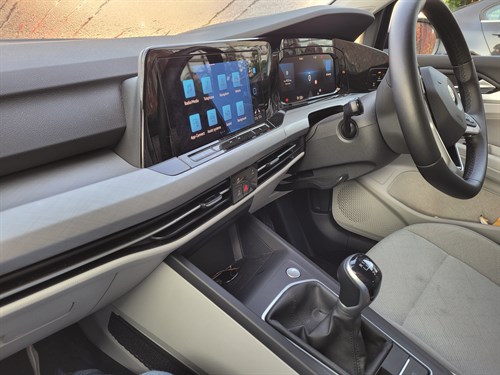
The incorporation of new technology and minimalist dashboard layouts is important for all new cars, but in several cases with the Golf, it's to the detriment of other features. The Bluetooth connectivity, for example, has a tendency to drop in and out, and struggle to connect when jumping in the car - an issue I never had in the previous-gen Golf. The new screen design leaves nowhere to rest your hand when operating it, causing you to inadvertently adjust the touch-sensitive volume controls with your palm. These are both small nuisances, and something I've ultimately learnt to live with, but they're still something you will likely encounter every single day.
Speaking of daily nuisances, the most recurring frustration I've had with the Golf relates to its safety and driver assist features. Just to be clear, these are far from all-bad. The adaptive cruise control is flawless and its lane departure warning system adds excellent peace of mind. As mentioned in a previous write-up, however, the 'Traffic hazard warning is currently restricted' message that pops up after five minutes, every time you start the engine, is infuriating. And it can lead to other driver assist features being disabled as a result. I still have no idea what this is all about, even after extensive research. Could this sensory overload be rectified with a software update? Probably, yes. But, as of the writing of this article, there still doesn't seem to be a solution.
As has been the case almost every month when writing these updates - and when speaking to friends and family, I come to the same "it's good at being a Golf, but the new tech leaves much to be desired" conclusion. This phrase can be attributed to a lot of new cars on the market, however, as a lot of brands effectively search for new ways to reinvent the wheel in order to avoid stagnation in new model ranges.
Fortunately for Volkswagen, the changes needed to fix the aforementioned inconveniences in the Golf seem to be relatively minor, and require finessing rather than overhauling. But the bothersome dashboard dings and inconsistent smartphone connectivity might just be enough to put off wannabe Mk8 Golf owners.
6th Report: I am a passenger
As a driver, it's easy to jump in a car and forget about what's going on with your passengers in the back seats. Who is fighting for elbow room? Whose knees are up to their chest? Whose hair is ruined by the roofline. That is, of course, until you become a passenger yourself.
Between my wife and I, our one-year-old and the dog - and our out-of-the-house-at-6am hiking lifestyle - we do tend to find ourselves juggling boot and rear passenger space, daily. The usual set-up is two adults in the front, the baby in his rear seat and the dog in the boot. The problem here is that adding an extra passenger, or a weekly shop, requires a bit of finessing.
But it's important to note that the Golf does indeed offer a solid passenger experience when you're not trying to cram loads in.
Up front, headroom, legroom and footwell space is spot on. There's enough room to stretch out, recline and prop your elbow up on the window ledge for a nap if need be. Your knees may prevent you from opening the glovebox all the way, but that's the case with most hatchbacks. As mentioned in a previous report, door bin space is generous, and the felt lining ensures that sweets and accessories don't rattle around. There's even some netting mounted on the side of the centre console, which I actually used for a pack of tissues during one of our morning hikes.
The wide windows, which reach past the shoulders, also do a great job of making the cabin feel cosy and airy. As a passenger, I also noticed how incredibly slim the A-pillars in the Golf are - which again are great for all round airiness, and they're also a huge help when assisting the driver in checking for oncoming traffic at junctions.
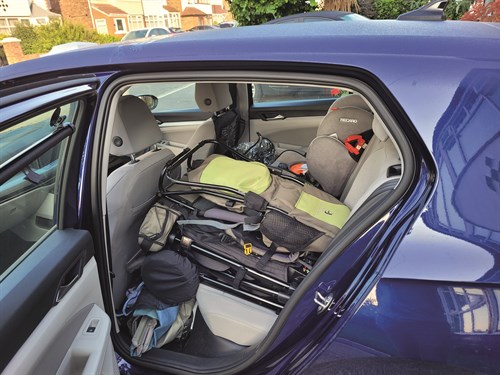
A small passenger criticism of the cabin, however, is the slight awkwardness of accessing the touchscreen system. As with a lot of cars, the Golf's is angled slightly towards the driver for ease of use. This certainly doesn't prevent you as a passenger from navigating it, but I did find myself occasionally clicking the wrong button and craning my neck for a better, square-on view of the satnav. The central cubby storage in front of the gearstick is also tailored predominantly for the driver, leaving the passenger with a slight hurdle to reach over if they want to store their phone or spare change.
Life as a rear passenger is much the same: there's plenty of head, leg and footwell room, a midriff armrest makes lounging easy, and the stretched window design eliminates any claustrophobia. However, when sitting in the back and looking ahead, you soon realise just how raked the Golf's windscreen is. This doesn't necessarily make the rear passenger experience uncomfortable, but it's worth keeping in mind if you have kids that like to watch the road ahead.
We have found the ski hatch access to the boot incredibly useful, especially with the dog. Of course, this access doubles up as an armrest for added comfort, with two convenient cup holders thrown in for good measure. I found the air con vents in the rear to be particularly impressive in terms of power and directional flexibility too, and they were a lifesaver given the heat wave we have recently endured.
Unfortunately, with the baby seat fitted, you're not going to be able to squeeze a middle passenger in - even if they're a stick-thin adolescent. Remove the baby seat and things are a little better, although the restricted footwell room is a nuisance for adults, and you'll undoubtedly be knocking elbows with each other the entire journey.
The only real issue you'll encounter in terms of passenger practicality with the Golf is when giving someone a lift. Assuming we always have a baby seat fitted, that leaves space for just one rear passenger. However, if we have either the dog or shopping in the boot, that passenger space is taken up by the pram. In theory, we could put the pram in the boot with the dog, but for safety reasons we avoid that. We find ourselves in this situation so frequently that we have bought wheel covers for the pram to ensure the rear seats stay clean.
The common denominator here, at least for us, is the lack of space for a middle seat passenger when a baby seat is fitted. This is pretty much the case with any small-to-midsized hatchback or SUV, however. Even if you take the dog out of the equation - which will certainly give you a bit more freedom, practicality-wise - you are still going to be limited to one additional adult in the back.
5th Report: Extra! Extra!
Navigating the rows upon rows of optional extra tick boxes when choosing your new car can be akin to visiting the supermarket when you're hungry; expensive, stressful, and somehow you always end up forgetting something you needed and bagging something you didn't.
Our Golf is part of the Life range, which is technically the cheapest grade you can buy - and is officially one of ten different Golf equipment levels. The idea behind us testing this specific Golf was to experience what it's like to live behind the wheel of a bare-bones family hatch. However, as is mostly the case with cars supplied to media, we kindly had some choice optional extras fitted to our model to give us some extra talking points that might be of interest to customers. So, what are they and are they worth the investment? It's worth noting that every Golf comes with satnav, DAB radio and a digital TFT display behind the wheel - so a lot of techie must-haves are covered.
First off, the glitter. The big aesthetic costs are its Atlantic Blue metallic paint job and its 17in Ventura alloy wheels, which per our car's spec sheet cost £625 and £615 respectively. Colour options in the Golf are a little limited, with even the most basic white and grey setting you back £380. With that, the price of the eye-popping metallic Atlantic Blue paint doesn't seem that steep. As for the alloys, they look very sharp - GTI-esque in fact. The standard 16in Norfolk alloys won't cost you a penny, but they do look astonishingly average - with the Ventura wheels being the cheapest upgrade available.
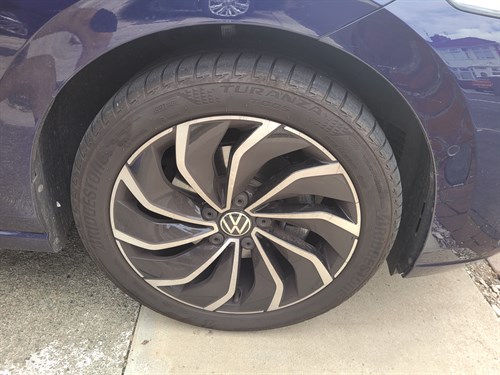
Next is the Winter Pack, which costs £550 and adds heated front seats, heated steering wheel and headlight washers. Heated anything is a luxurious game changer for many, so we'd argue it's worth it. Keep in mind, however, that there is a pricier upgraded Winter Pack with rear heated seats that will set you back £1,200.
The Lounge Pack (£400) is a strange one, as it essentially cherry-picks a few more advanced features from higher up grades, with the key addition being three-zone climate control. It also adds a ton of extra LED lighting colours and strips throughout the car. If you're likely to have rear passengers, like kids, the hike in price is probably worth it.
The biggest cost addition of all comes in the form of the Driver's Assistance Pack (£785), which combines a few different intelligent, semi-autonomous options to ultimately offer a more convenient, safer drive that comes out at around £100 cheaper than if you were to spec them individually. These bundled features include Travel Assist, Side Assist and Park Assist. The big highlights here include lane departure warning, lane keep assist and adaptive cruise control, of which can accelerate/decelerate accordingly and nudge the steering wheel to keep you in lane. You also get heated door mirrors, puddle lights and autonomous parking aid for parallel and bay parking. For £785, this is pretty impressive value for money, especially if you're on-board with autonomous tech.
There is an argument, however, that the sheer amount of cameras, radars and sensors that such assistance packs offer, potentially serve up more dings, errors and things that can go wrong with the car. I have certainly experienced a heady amount of bleeps and dings for no apparent reason while driving. Features like lane keep assist can be intrusive at times too, so much so that I tend to find myself turning it off - but that's just me. Personally, I would skirt the all-encompassing Driver's Assistance Pack - albeit great value for money - and aim to spec the kit you think you'll use on a daily basis - the big one for many being adaptive cruise control. If you must have autonomous parking features, even for amusement, Park Assist will only cost you £200 anyway.
A few other extras listed on the spec sheet included front and rear carpet mats (£100), a space saver spare wheel (£100) and high beam assist (£145) - all of which are likely worth keeping checked for convenience, especially the latter, which can automatically dip your high beams when driving at night.
As with many modern cars, the fork in the road with optional kit and significant additional costs will be autonomous tech. Things like adaptive cruise and lane keep assist can massively enhance ease of driving, but too much sensory tech can cause a bit of a technological bottleneck and become an inconvenience. Keep that in mind when you're thinking of trying to recreate KITT from Knight Rider on the online configurator.
4th Report: Road trippin'
Setting out to test a car in a specific area - like a busy city, packed motorway or potholed housing estate - is one thing, but nothing quite reveals a car's boons and foibles like a road trip. Since our nine-month baby boy came along, we've been limited to local walks and exploration, due to the ongoing pandemic. But with self-catered stays officially allowed as of April 2021, we wanted to venture south - as far south as possible, in fact, all the way to St Ives, Cornwall.
I was keen to put the trusty Golf to the test, too. So far, I'd found the Golf pretty solid, with its only Achilles' heel being its problematic infotainment system. Packing the car required some contortion of cargo, but this was likely due to us overpacking rather than the Golf lacking practicality. The pram took up a large chunk of the boot space, but we found the rear footwells particularly spacious, each of them swallowing a large beach/cooler bag each. This made
accessing drinks and snacks on the road incredibly easy. The cabin's conveniently-sized cup holders and deceivingly-deep door bins served us well too.
Contrary to the heady criticism I have given the Golf's infotainment system, the sat-nav didn't fail us. In fact, I found it better than most. The progress bar featured to the right-hand side of the screen displays upcoming rest stops, there's 3D inner-city map graphics, the map route is clear to follow and even without the voice alerts turned on, there's plenty of pop-ups to ensure you don't miss a turn - both on the touchscreen and behind the steering wheel. The only slight hiccup was the system's tendency to mistake some junctions for roundabouts, but this happens to the best of systems.
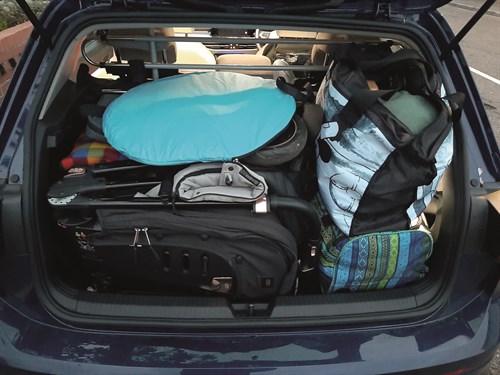
The system wasn't without its faults, however. While the sat-nav did its job perfectly, the Bluetooth was another story. Both mine and my wife's phones connected and disconnected to the car's system some ten or 20 times during the journey. I discovered that two phones connected at the same time can cause some crossed wires, but even when trying to connect just one phone I still encountered problems. The only other notable nuisance was the "Traffic
hazard warning is currently restricted" pop up. Essentially, this pops up five minutes or so after setting off - and has, once or twice in the past two months, had a knock-on effect
with the car's driver assist features, in that they end up being disabled. This has been bugging me for months. I've researched it and foraged through VW fan forums everywhere and ultimately come to the conclusion that it's a hardware issue that needs fixing/updating by Volkswagen - something that, much to the chagrin of Golf owners, has yet to happen.
The driver assist features are excellent in the Golf though. Our six hour motorway jaunts were made much easier thanks to the Golf's lane keep assist, lane departure warning and, most of all, its adaptive cruise control. The adaptive cruise works effortlessly, accelerating and decelerating where appropriate, both when approaching a car from behind and changing into clear lanes on the motorway. Speaking of cruising, we managed to get 55mpg consistently at motorway speeds, with our average mileage for the entire 967 mile journey being 52.6mpg - and that's including a hell of a lot of second gear hill-climbing.
Overall comfort wise, the Golf is excellent too. While the ride is a little firmer than previous gen Golf's, it's not unsettled by any means. And while there's a little tyre roar, you can still speak at regular volume to your passengers. The Golf surprisingly didn't feel any heavier or more cumbersome when crammed with luggage either - acceleration was smooth and cornering was unhindered. Even after almost 1,000 miles of driving, I didn't feel fatigued or put off driving the Golf. I've certainly felt much worse after shorter journeys, in bigger cars.
3rd Report: Longing for simpler times
Over the past ten years or so, carmakers have been hastily developing in-car entertainment systems to accommodate barrages of new, sophisticated tech. But things seem to have reached a bit of a plateau, with even secondary market competitors able to offer feature-packed touchscreens with seamless active safety features, satnav and Wi-Fi operation. That's why the system in the Mk8 Golf is such a crushing disappointment, as it fails to deliver on the fundamentals, let alone the fanciful.
The latest Golf's pitfalls are well documented, and it's not a stretch to say that the infotainment system in the Mk8 simply wasn't ready to be sent out of the factory. What we get is something that feels like it's still in beta testing. And, unfortunately, it's not just the advanced features that suffer from an unfinished feel.
But let's take a step back for a second - it's not all doom and gloom. The look of the 10in touchscreen matches the Golf's trim and uncomplicated cabin design perfectly. The icons are crisp, clear and smartphone-like, and many of the menus offer a pleasingly simple layout - including the phone and driver data menus. Having visual representations for the driver assist and interior/exterior functions within the settings menu is a nice touch too; clicking a picture of road markings adjusts the lane keep assist and a floating coffee shop button is used to toggle the fatigue monitor. These are both great examples of making nuanced tech easy to understand.
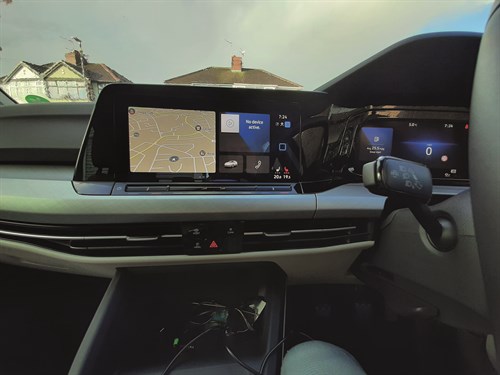
Aside from that, the overarching theme is one of frustration and what seems like general lack of common sense from a development point of view. The screen's menus feel as though they were designed to be used on desktop, with three, four or sometimes five clicks required to achieve what would otherwise be accomplished via a button press or knob turn.
You'll likely find yourself relying on Google to locate certain features hidden within the system - and that includes some of the most basic things, like where the main menu button is (no, I'm not kidding) and how to access the core settings menu to adjust the clock (this took me the best part of a month, and I still had to YouTube it). These features aren't hidden as such, their locations just aren't glaringly obvious. Finding the settings menu, for example, required me to simply swipe down on the main menu in order to access icons I didn't even know existed.
I found myself constantly questioning whether I was overthinking things and wondered whether my previous test car knowhow was hindering me.
A few other nuisances that arise day-to-day is the Bluetooth not connecting properly, the satnav displaying all locations as "off-road", the touch-sensitive temperature and volume controls getting accidentally pressed due to being positioned underneath the screen, and the touchscreen in general taking several seconds to register clicks and swipes.
There are certain menus and personalisation features I'm yet to explore in the Golf, but to be honest, I'm hesitant to. Using the Golf's top level menus is akin to navigating an undomesticated hedge maze, delving deeper would surely present me with multiple dead ends.
I have no doubt that all the features you're ever going to need exist within the Golf's touchscreen. The problem is, no matter how much you attempt to learn its idiosyncrasies, you'll never trump its tendency to just go wobbly. Its software simply isn't good enough.
2nd Report: Family-proof?
The humble hatchback has long been an essential part of the new family starter kit, with the word hatchback itself seemingly carrying some sort of limitless, mystical, does-a-bit-everything connotations. But how does that play in the real world?
With an eight-month old baby, a Beagle that constantly needs walking and an activity limiting global pandemic, the past few months has been a constant cycle of supermarket visits and National Trust walks. And to be fair, it's been pretty ideal testing conditions for a hatchback's family credentials. So how has the Golf served us?
Up front, we never seem to be wanting for cubby space. Finding a place for fists full of receipts, chocolate bar wrappers and bottles of water is always easy, thanks to large, strategically-shaped door bins. The door bins are carpet-lined too, which stops things knocking about. The glovebox has enough space for a glasses case or two, and a packet of baby wipes, but you'll likely find yourself solely using the door bins more often than not - or the wide cubby in front of the gearstick.
The two centrally situated grippy cup holders on offer vary in size, with one of them featuring a fancy, flip-out surround to accommodate a variety of different vessels - although it only really tailors to small or large cups and bottles, not medium.
At the rear, the doors open to almost 90 degrees, which is great. The low-ish roofline can make it difficult when it comes to loading and strapping the baby into his car seat, although this is a general inconvenience of pretty much every hatchback, and isn't helped by the fact that our current car seat sits on a booster-like base.
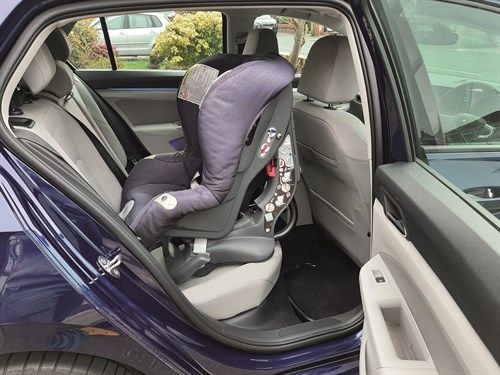
With the car seat in place, there's very little space between it and the front seats, so if you're a six footer, keep this in mind, especially as you'll likely opt for the baby to sit behind the driver so the front passenger can lean back and attend if need be.
The rear of the front seats come with handy pockets in the back of them - one large pocket and two, higher-mounted smaller ones. These are great if you have a forward-facing child seat, as they can be used to store toys.
A quick note on Isofix anchors. I used to think these were absolute essentials when it came to securing a child seat. They're not. While the Golf has Isofix fittings on both rear seats - and indeed some child seats can be secured with said fastenings -we're on our third child seat (one of which had a separating base) and are yet to even look at them. Instead, we strap the seat in via the seat belt, which is quick, easy and secure.
Space and convenience is impressive all-round in the rear of the Golf. There's easily enough head, leg and elbow room for adults. The footwells have enough space for a few shopping bags too. I particularly like the fact that the rear windows stretch slightly past your shoulders, giving a light and airy feel for both adults and kids. Also, while the light upholstery makes for a cosy interior, we've already started to feel the stress of muddy paw prints. Conversely, it hides beige baby food stains quite well.
The 400-litre boot in the Golf swallows most things - including the dog. The main thing you'll have to debate is whether to have the floor lowered or not. When it's flush with the load lip, you get a smooth, unintrusive base. This is particularly handy when loading a pram. However, when you lower it, you get an extra six inches of vertical space, but a bit of a drop. Personally, the lowered floor makes more sense for us - it stops the shopping falling out when unloading and the dog craning her neck when sat upright.
At the moment, the Golf is managing very well. But I can certainly sense its limits. Introduce a flailing toddler and a few bikes into the mix, and I'd be thinking of upgrading to the SUV club.
1st Report: The Golf life
You don't need us to tell you how popular the Volkswagen Golf is. It's one of those rare things that manages to be ubiquitous and yet cult at the same time. It used to be the only go-to family hatchback that offered brand prestige, solid reliability and Germanic-style luxury at an affordable price. That isn't the case anymore, with everyone from Peugeot to Kia fighting for the same piece of the pie. So, in the modern day adapt or die hatchback market, is the Golf still relevant?
Having recently become a dad, I was excited at the prospect of running the staple family car for an extended period of time. And as our test car came specced in the entry-level Life trim, I was curious to see what a 'cheap' Golf actually has to offer.
The Storm Grey upholstery was a shock - but a welcome one. In my mind's eye, every hatchback has a dark interior with varying amounts of chrome and scratchy plastics. The grey interior of this Golf makes for a much warmer, cosier cabin and it's a wonder why lighter interiors aren't the norm. It works for Volvo.
Volkswagen hasn't pulled any punches on the tech front with the eight-generation Golf. Every example gets an almost buttonless dashboard, with a centrally-mounted 10in touchscreen and a 10in display behind the steering wheel. Between these two screens, the average driver won't want for anything - with a 3D map satnav system, DAB radio, Apple Carplay and Android Auto, parking sensors and adaptive cruise control all included. You even get luxury features like keyless start and 10-colour ambient lighting. Five years ago, you'd have assumed we were talking about an Audi with those specs.
While we do have the Life version of the Golf, there's also a few optional extras fitted, which mostly add to the function rather than the fit of the car. The main attractions are the winter pack and driver's assistance pack. These give the likes of heated seats (and steering wheel) as well as lane keep assist and lane departure warning.
So the Golf has lots of kit to offer, even without the optional extras. Navigating the screen's menus and options, however, is another story. It's far too early to deliver a verdict on the functionality of the touchscreen, but let's just say it's a learning curve, even for a fairly well-versed techy like me.
Those looking for a foot in the door of Golf ownership can choose between either a 1.0-litre TSI or 1.5-litre TSI petrol - each offering six-speed manual and DSG automatic options, as well as mild-hybrid eTSI variants. Our car comes fitted with the 130hp 1.5-litre four-cylinder turbocharged petrol mated to a six-speed manual gearbox. This 1.5 feels a lot like the good ol' 1.2 turbo of yesteryear, with just enough power and smooth, effortless acceleration - although it does require you to rev it if you want to do anything but mosey along.
The mild-mannered 1.5 suits the Golf's persona well though. Like many other small VW-Group cars, the Golf very much feels like it drives itself, which when you're nipping to the shops or checking on the baby in the back seat, isn't such a bad thing at all.
I'm looking forward to seeing how it handles family life in the coming months, especially considering that my son is edging towards the end of his grab-everything, multiple car-seat-requiring first year. But, so far, so Golf.
Standard equipment:
Discover Navigation system with 10in touchscreen, Active Info Display, 10in high-res TFT dash display, ACC Adaptive Cruise Control, climate control, keyless start, ambient lighting, front and rear parking sensors, LED self-levelling headlights, Car-Net 'App-Connect'
Options:
Carpet mats £100
Winter pack including heated steering wheel £550
Driver's assistance pack £785
Lounge pack £400
High beam assist £145
Atlantic Blue metallic paint £625











